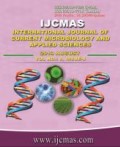


 National Academy of Agricultural Sciences (NAAS)
National Academy of Agricultural Sciences (NAAS)

|
PRINT ISSN : 2319-7692
Online ISSN : 2319-7706 Issues : 12 per year Publisher : Excellent Publishers Email : editorijcmas@gmail.com / submit@ijcmas.com Editor-in-chief: Dr.M.Prakash Index Copernicus ICV 2018: 95.39 NAAS RATING 2020: 5.38 |
The present investigation was carried out with the objectives of getting information on the magnitude of genetic variability for quantitative and quality traits in the bacterial wilt tolerant genotypes of bell pepper (Capsicum annuum L. var. grossum Sendt.). The experiment material consisted of 43 genotypes (39 bacterial wilt tolerant genotypes, two resistant, one moderately resistant and one susceptible check) that were evaluated in Randomized Complete Block Design (RCBD) during summer-rainy season, 2018. Data were recorded on days to 50 per cent flowering, days to first picking, plant height (cm), primary branches per plant, harvest duration (days), fruit length (cm), fruit width (cm), pericarp thickness (mm), lobes per fruit, average fruit weight (g), marketable fruits per plant, marketable fruit yield per plant (g), capsanthin content (ASTA units), TSS (ºBrix) and ascorbic acid content (mg/100g). The analysis of variance revealed significant differences among genotypes for all quantitative and quality traits. Among all, genotypes DPCBWR-14-39 (541.44 g), DPCBWR-14-36 (510.30 g), DPCBWR-14-2 (448.93 g), DPCBWR-14-35 (424.34 g) and DPCBWR-14-29 (421.49 g) were the highest yielders and these were also among the top genotypes for economic traits viz., marketable fruits per plant and average fruit weight. The estimates of GCV were lower than the respective PCV, indicating the influence of environmental factors on the expression of the traits studied. The estimates of PCV and GCV were high for marketable fruits per plant, marketable fruit yield per plant and capsanthin content depicting the presence of substantial variability and would response better to selection. High heritability coupled with high genetic advance was observed for fruit length, marketable fruits per plant, marketable fruit yield per plant, capsanthin content and ascorbic acid revealing the importance of additive gene action and could be improved through direct selection.
 |
 |
 |
 |
 |